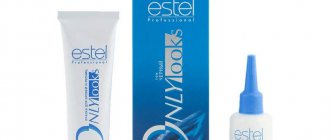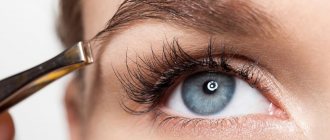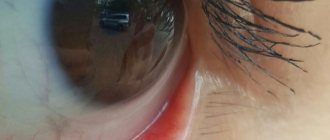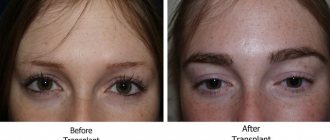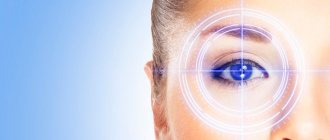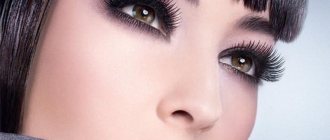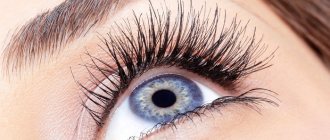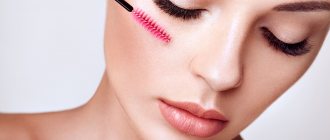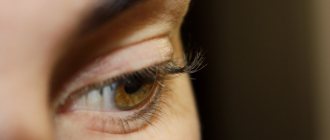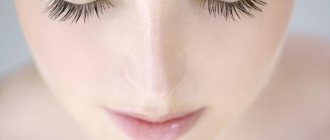Causes of the disease
Among the main causes of madarosis, experts identify a lack of vitamins in the body, the presence of chronic diseases, an unbalanced diet, endocrinological diseases, long-term use of certain medications, allergies to facial cosmetics, as well as ophthalmological problems - blepharitis and demodicosis.
When eyelashes fall out in women, first of all you need to pay attention to facial cosmetics. Very often, mascara, eye shadow and makeup removers can cause allergic reactions, which cause madarosis. In this regard, it is necessary to conduct a complete inventory of the cosmetic bag, identify and isolate “inappropriate” elements, carefully studying their composition. In the future, when purchasing decorative cosmetics, be sure to pay attention to the composition of the products and their production time. In addition, if possible, avoid new products from unknown manufacturers.
Etiology
Many etiological factors have been described that lead to impaired growth of eyelashes and eyebrows. Madarosis can be a consequence of local changes or systemic pathologies. Leading causes of the disorder:
- Injuries.
In the area of traumatic injuries, keloid scars may form, on the surface of which there is no hair. Similar deviations occur with burns. Damage to the hair follicles is observed in obsessive-compulsive disorder (trichotillomania, trichoteiromania, trichothemamania). - Blepharitis.
Chronic inflammation of the eyelids, accompanied by periods of remissions and exacerbations, leads to eyelash loss. Blepharitis of staphylococcal nature is often observed with rosacea. Trachoma is a rarer cause, but leads to irreversible consequences. - Dermatological diseases.
Madarosis occurs as a result of a number of skin diseases that cause itching and dryness. The most common among them: atopic dermatitis, seborrhea, ichthyosis. In women over 50 years of age, the main cause is postmenopausal frontal fibrosing alopecia. - Taking medications.
Hair growth is directly affected by prolonged use of heparin, anticonvulsants, and androgens. Generalized changes in hair growth occur with the use of chemotherapy drugs. - Intoxication.
Thallium and mercury poisoning leads to alopecia areata, dysfunction of the nervous system and gastrointestinal tract. With hypervitaminosis A, retinoids have a toxic effect on the skin and its appendages. - Neoplasms.
Hair regrowth is difficult with malignant tumors: sclerosing sweat gland cancer, basal cell and squamous cell carcinoma. Madarosis occurs in systemic mastocytosis and cutaneous T-cell lymphoma. - Endocrine diseases.
Hair follicles become affected in response to thyroid dysfunction. With hypo- and hyperthyroidism, hair growth is disrupted at the cellular level, so the entire hairline suffers. - Nutrient deficiency.
The disease occurs with nutritional deficiency, manifested by hypoproteinemia and deficiency of vitamins and microelements (zinc, iron, vitamin B7).
- Ophthalmologic: blepharitis. Anterior blepharitis is either staphylococcal or seborrheic, and posterior blepharitis is caused by a blockage of the meibomian glands.
- Dermatological conditions: There are several types of dermatological conditions that can lead to madarosis. These include atopic dermatitis, seborrheic dermatitis, psoriasis. Also: frontal fibrosing alopecia, keratosis pilaris, rosacea, telogen effluvium, mycosis fungoides and sarcoidosis.
- Nutritional disorders: Severe malnutrition can cause chronic hair loss. Hypoproteinemia, lack of biotin and iron causes degeneration of hair follicles. Zinc deficiency, such as in acrodermatitis enteropathica, can lead to eyebrow/eyelash hair loss. Also leads to hair loss.
- Infections: There are many bodily infections that can cause loss of eyelashes/eyebrows. Lepromatous leprosy, syphilis or other viral infections such as herpes or HIV can also cause eyelash loss, as well as fungal infections (paracoccidioidomycosis, trichophyton or microsporum).
- Trauma: Most traumas are caused by madarosis from a psychological point of view, known as trichotillomania.
- Drugs/Medications: Crack cocaine or chemotherapy drugs. Other drugs include: propranolol, valproic acid, barbiturates, MMR vaccine, botulinum toxin, epinephrine, antithyroid drugs, anticoagulants and lipid-lowering drugs.
- Genetics
- Autoimmune disorders: alopecia areata, discoid lupus erythematosus, chronic cutaneous lupus erythematosus, Graham-Little syndrome and Parry Romberg syndrome
- Other diseases: hypothyroidism, hyperthyroidism, hypoparathyroidism, hypopituitarism, amyloidosis and congenital erythropoietic porphyria (Gunther's disease)
Treatment of madarosis
If the disease has just begun with profuse eyelash loss, you just need to give them a “rest.” That is, for two weeks, give up makeup or at least stop dyeing your eyelashes. During this time, they will become noticeably stronger and will be able to recover.
Vegetable oils are effective means of restoring the growth of eyelash hair and strengthening existing ones. The best results are shown by using castor oil and flaxseed oil. Before using them, you need to comb your eyelashes with a special brush and only then apply oil along the hairline with a regular cotton swab. It is better to perform this procedure at night before going to bed.
An excellent means of restoring hair and improving its growth is vitamin E. This is an oily substance that must be applied to the eyelashes with a brush from roots to tips. To improve the effect, vitamin E capsules should be taken orally according to the instructions.
The use of traditional medicine recipes shows very good results in the treatment of madarosa. To restore damaged eyelash hair follicles and improve the appearance of eyelashes, infusions of medicinal herbs are excellent: cornflower, chamomile, calendula, eucalyptus, sage, etc. They are used in the form of lotions or compresses on the eyes twice a day. The exposure time of compresses with herbal infusions is 10-15 minutes, the best time is morning and evening.
Fragility and loss of eyelashes are very often associated with a deficiency in the body of vitamin E or A, as well as B vitamins. In this regard, to combat madarosis, it is very important to pay attention to the foods that make up the diet. The condition of your eyelashes will definitely improve if you supplement your daily menu with portions of tomatoes, sweet peppers, carrots, leafy vegetables, fruits, herbs, fatty fish, and liver.
Modern pharmacology also offers an extensive line of medicinal cosmetics, the use of which gives quick results in treating eyelash loss and improving their appearance.
If there are no results from treating madarosis at home. Be sure to seek advice from a specialist. Perhaps the cause of eyelash loss is a systemic disease, the treatment of which, in order to avoid serious consequences, should be handled exclusively by a doctor.
Treatments
Lush, thick eyelashes and eyebrows most often occur in women who lead a healthy lifestyle, go to sports training, and take care of their well-being. Such ladies are scrupulous when choosing cosmetics, preferring only proven products.
Among the care procedures that must be performed regularly for both eyebrows and eyelashes are the following:
- Morning and evening combing of hair. To do this, you can use a clean mascara brush.
- In the evening at home after a shower, coconut, castor, burdock, and sea buckthorn oils should be applied to the bristles. Professionals advise alternating oils or constantly using the one you like best.
- During an oil session, it is useful to perform a mini-massage of the eyebrows and eyelashes. The areas are first stroked with the pads of the fingers, then lightly pinched.
- Massage will stimulate the hair follicles and provide a rush of blood to them. As a result, hair will grow thick and strong.
Note! It is useful to please your eyelashes and eyebrows by applying a paste of fresh parsley to them with the addition of a drop of the oil preparation Aevit.
In the beauty salon, masters offer the following wellness sessions for the main facial accessories:
- lamination;
- restorative course of procedures.
Prevention of madarosis
In order for eyelashes to stop falling out and grow strong and healthy, it is necessary to pay enough attention to your diet and ensure that your body receives sufficient amounts of vitamins A, E, and B.
In summer, it is necessary to use sunglasses, as direct sunlight weakens and destroys hair and eyelashes.
Women must remember about the adverse effects of decorative cosmetics on eyelashes. When removing it, it is better to avoid soap, which dries out the skin, which loses its strength and is unable to withstand harmful influences from the outside. Use vegetable oils to maintain the vitality of eyelash bulbs.
By contacting the Moscow Eye Clinic, each patient can be sure that some of the best Russian specialists will be responsible for the results of treatment. The high reputation of the clinic and thousands of grateful patients will certainly add to your confidence in the right choice. The most modern equipment for the diagnosis and treatment of eye diseases and an individual approach to the problems of each patient are a guarantee of high treatment results at the Moscow Eye Clinic. We provide diagnostics and treatment for children over 4 years of age and adults.
You can find out the cost of a particular procedure or make an appointment at the Moscow Eye Clinic by calling 8(499)322-36-36 or using the online appointment form.
What is trichiasis of the century?
Trichiasis should be distinguished from entropion of the eyelid, which sometimes occurs in older people. With trichiasis, the structure of the eyelid remains normal, the direction of eyelash growth is simply disrupted, this occurs as a result of a change in the location of the hair follicles.
Doctors distinguish several types of eyelid trichiasis:
- complete trichiasis , or madarosis (the entire row of eyelashes begins to grow towards the cornea);
- partial trichiasis (only some eyelashes protrude towards the eye);
- unilateral (improper eyelash growth in one eye) and bilateral trichiasis (pathology observed in both eyes);
- distichiasis (one extra row of eyelashes growing towards the eyeball);
- districhiasis (two additional rows of eyelashes, quite rare).
With trichiasis, abnormally growing hairs are usually colorless and thin, so it is quite difficult to see them with the naked eye. A slit lamp with good magnification is required for an accurate diagnosis.
Our doctors who will solve your vision problems:
Fomenko Natalia Ivanovna Chief physician of the clinic, ophthalmologist of the highest category, ophthalmic surgeon.
Surgical treatment of cataracts, glaucoma and other eye diseases. Yakovleva Yulia Valerievna Refractive surgeon, specialist in laser vision correction (LASIK, Femto-LASIK) for myopia, farsightedness and astigmatism.
Gigineishvili Darejan Nugzarevna Retinologist, retina specialist, conducts diagnostics and laser treatment of retinal diseases (dystrophies, ruptures, hemorrhages).
Dagaev Adam Huseinovich
Functions of eyebrows
You should especially worry if your eyebrows fall out in adulthood. The reasons for this are worth finding out because they perform several important functions for the body.
Firstly, they add expressiveness to the eyes. How others perceive you largely depends on your eyebrows. After all, no matter what they say, the proverb “one is greeted by one’s clothes” has not been canceled. And your appearance and facial expression are no less important than what you wear.
Secondly, they protect your eyes from dust and water particles. In general, you shouldn’t initially be afraid that your eyebrows will fall out. The reasons can be the most harmless. After all, in essence, it is hair. And they constantly need updating. Therefore, from time to time some hairs fall out, and others appear in their place. This is a natural process that cannot be prevented, and there is nothing to worry about.
But sometimes eyebrows fall out for completely different reasons. You should be concerned if this happens too often and intensely. This scares every person, so you need to know why this happens, how to deal with it, and what the threat may be.
Features of eyebrow care at home
It is much easier not to treat diseases, but to prevent their development.
Causes of eyebrow loss
To prevent eyebrow loss, you should follow the recommendations below:
- You should comb your eyebrows daily with a special cosmetic brush. Thanks to this simple procedure, it is possible to stimulate blood microcirculation in certain areas.
- If your eyebrows are fading and thinning, then you should refrain from tinting them. In general, it is recommended to avoid the use of low-quality dyeing products that contain a high concentration of aggressive substances.
- The cosmetics used must be of high quality. You cannot save on yourself and your health; you should always check the composition.
Note!
You should especially carefully study what eyebrow pencil and mascara are made of. The substances included in their composition can have an extremely negative effect on the condition of the hair.
- After waking up in the morning, you need to wash your face with cool water. When using skincare products, such as toners, you should avoid contact with the eyebrow area.
- Compliance with proper nutrition and drinking regime plays an important role. The extent to which the hair follicles are supplied with oxygen and nutrients depends on this. It is recommended to enrich the diet with cereals and legumes, as well as nuts, vegetables and fruits, and dairy products.
- If possible, you should avoid stressful situations, since in a large number of cases they are the cause of hair loss. If your nerves begin to bother you, you should do everything possible to normalize your psycho-emotional background.
What to do if your eyebrows are thinning
If your eyebrows begin to thin and you cannot determine the cause on your own, then you should not let the situation take its course. In this case, you need to undergo a medical examination as soon as possible and exclude the possibility of developing specific diseases. A trichologist will help identify the root cause. It is he who must examine the condition of the skin and hair follicles, give directions for the necessary tests, and then prescribe treatment. As a rule, the approach to therapy is complex, which includes:
Vitamin complexes
Often, hair loss on the head and eyebrows indicates that the body is experiencing a deficiency of vitamins, macro- and microelements. The doctor may prescribe vitamins in the form of injections, capsules or oils depending on the severity of the lesion.
How to deal with eyebrow loss
To strengthen, awaken and restore the follicles, the following are prescribed:
- B1 to combat stress and depression;
- B2 for restoration of the hair follicle;
- B3 and B6 help normalize metabolism in the body;
- B7 is effective for alopecia;
- thanks to vitamin B8, other vitamins, macro- and microelements are absorbed;
- B9 and E regenerate renewed cells;
- B12 enriches cells with oxygen;
- ascorbic acid (vitamin C) strengthens the immune system.
On a note!
In most cases, multivitamin complexes serve as the fundamental basis for the fight against eyebrow loss.
Medications
If a course of treatment with vitamins does not provide the desired result, the doctor may prescribe a medication called minoxidil. This is an effective vasodilator. The main indication for its use is alopecia (baldness).
This solution not only slows down the process of hair loss, but also stimulates the development of new follicles and strengthens old ones. The effect of use is cumulative, duration of use is from 3 to 6 months.
Oils
Plant-based pharmaceutical oils can also help in the complex fight. You need to make eyebrow masks from them. To treat baldness, it is recommended to use dwarf palm oil, as well as castor, wheat germ, almond, avocado and burdock oils.
Strengthening procedures
For baldness, therapeutic procedures are effective, for example, professional massage or any physical procedure that helps strengthen and grow hair follicles.
Restoring lost eyebrows often requires the help of a qualified professional; you should not be afraid of them. The procedures are not painful and do not cause discomfort.
Masks against hair loss
There are a large number of folk recipes that prevent baldness:
- Onions with calendula. To prepare, you will need to prepare 1 onion, peel it and chop it. Using gauze, squeeze out the resulting pulp. Combine it with castor oil (15 ml), calendula tincture (15 ml), natural honey (12 g), egg yolk and cognac (10 ml). Mix all components thoroughly with each other and apply to the affected areas. Duration of the procedure is 25 minutes.
- Castor oil with burdock oil. To prepare, you will first need to keep the aloe stem in the freezer for a day. Then squeeze out about 30 g of gel from the plant, then combine with burdock oil, castor oil and honey. Mix all the ingredients and start rubbing into the affected areas. In 20 minutes. you need to rinse everything off with cool water.
If your eyebrows begin to fall out, you should immediately take appropriate measures, but do not fall into despair. This is quite common and in most cases responds well to treatment.
Eyebrows constantly grow, fall off and are replaced by new ones.
. This is a normal process, like any other hair.
Under normal conditions, eyebrows rarely fall out. If you notice that baldness
, you need to react immediately.
If you ignore the problem, you can completely lose your own eyebrows.
In addition, such baldness may indicate internal diseases
.
